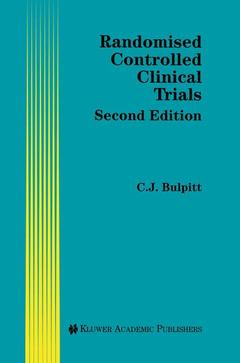Description
Randomised Controlled Clinical Trials (2nd Ed., 2nd ed. 1996)
Author: Bulpitt Christopher J.
Language: English
Subject for Randomised Controlled Clinical Trials:
Keywords
Publication date: 10-2012
437 p. · 15.5x23.5 cm · Paperback
437 p. · 15.5x23.5 cm · Paperback
Description
/li>Contents
/li>
After 13 years there are new areas to discuss and more recent trials to be included. Good clinical practice; evaluation of quality of life; measurement of the benefit:risk comparison; determination of cost- effectiveness and cost utility; stopping rules for trials; meta-analysis and subgroup analysis are all new sections. The references are expanded from 305 to 512 and include the recent advances in trial design, such as the n-of-1 trials and megatrials, and up-to-date examples to illustrate the points made in the 20 chapters.
1. Introduction.- 2. The history of controlled trials.- 3. Ethical considerations.- 4. The objectives of a randomised controlled trial.- 5. Different trial designs.- 6. How many subjects are required for a trial?.- 7. How to ensure that the results are free of bias.- 8. Writing the protocol.- 9. Recruitment of subjects.- 10. Information to be collected during a trial.- 11. The conduct of the trial — Good Clinical Practice.- 12. Stopping rules for trials.- 13. The variability and validity of results.- 14. Analysis of the results, subgroup and meta-analysis.- 15. The evaluation of subjective well-being and measurement of quality of life.- 16. The detection of adverse drug reactions.- 17. Measurement of the benefit; risk comparison, cost-effectiveness and cost-utility.- 18. Early trials on new drugs.- 19. Failure to accept the results of randomised controlled trials.- 20. The advantages and disadvantages of randomised controlled trials.- References.
© 2024 LAVOISIER S.A.S.

